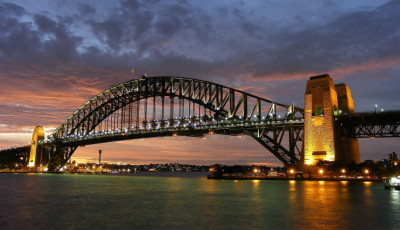
The Sydney Harbour Bridge was officially opened on March 19, 1932. An iconic structure in Sydney and one of the best recognized, photographed, and loved landmarks of the world, it is the world's heaviest steel arch bridge.
There are some human-made structures that are readily identified and immediately associated with the place in which they are located. Taj Mahal is one such structure that people world over connect with India. Similarly, there are two landmarks in Sydney- the Sydney Opera House and the Sydney Harbour Bridge- that have turned out to be prominent structures that people globally link with Australia.
Spanning the Sydney Harbour and connecting Sydney with its northern suburbs, the Sydney Harbour Bridge is about 1,150 m in length, with the top of the bridge standing 134 m above the harbour. Apart from having two rail lines and eight lanes for vehicular traffic, the bridge also has a cycleway for bicycles and a walkway for pedestrians.
An old idea
The site of the Sydney Harbour Bridge (both sides of the harbour) was home to Eora people (Aboriginal Australians) before the arrival of the Europeans in 1788. While the bridge came about only in 1932, the desire to span the harbour and the idea for its construction dates back over 100 years.
As early as 1815, Francis Greenway, an architect convicted of forgery in 1812, suggested the construction of a bridge across the harbour. In the decades that followed, the idea took many forms – a large cast iron bridge, a floating bridge, and even a tunnel. Some proposals were serious, some were even accepted, but nothing really materialised as the costs involved were prohibitive.
Father of the Sydney Harbour Bridge
This remained the case till the turn of the century as estimated costs meant that even satisfactory designs couldn't be pursued. It was in 1900 that civil engineer John Job Crew Bradfield first became involved with the idea. Over the next three-plus decades, Bradfield became the project's most vocal advocate and is even remembered as the father of the Sydney Harbour Bridge.
For Bradfield, the bridge was part of his vision for the suburban railway network's electrification. He used his influence to both promote and oversee the construction of the Sydney Harbour Bridge.
In 1912, Bradfield was appointed as the chief engineer of the Sydney Harbour Bridge and City Transit. Just when it looked like things were about to get moving, World War I put a halt to all plans.
International competition
It was in 1922 that the Sydney Harbour Bridge Act was passed by parliament. Calling for worldwide tenders for the 'Construction of a Cantilever or an Arch Bridge across Sydney Harbour’, Bradfield turned it into an international competition. After going through the 20 proposals from six companies, Bradfield and his team selected a two-hinged steel arch with abutment (substructure supporting superstructure) towers by English firm Dorman, Long & Co.
The turning of the first sod ceremony, which is a traditional ceremony in many cultures that celebrates the first day of construction, took place in July 1923. The four abutments served as the load-bearing foundation and from these the arch was built simultaneously from both ends. The construction of the arch began on October 26, 1928 and the two arches touched for the first time on August 19, 1930.
As the bridge became self-supporting once the span was complete, the bridge deck could be built and it was completed in June 1931. Load testing began in January 1932 and it was declared safe in the following weeks. While the official opening of the bridge took place on March 19, 1932, over 50,000 school children had already crossed the bridge by then in a series of "school days".
Jobs during the Great Depression
Over 1,600 people worked in the construction of the bridge through its near decade-long construction. With the economy slowing down and encountering a worldwide depression during the period, the bridge provided much-needed jobs across various work categories. It wasn't without danger, however, as at least 16 people died during the construction of the bridge.
In all, over 52,800 tonnes of steel was used, out of which 39,000 tonnes were employed in the arch alone. The cost of building the bridge alone was £4,238,839 and the total cost including other expenses was closer to £10 million – a debt that was paid off only in 1988. But then, the bridge handled over 200 trains, 1,60,000 vehicles, and 1.900 bicycles on average every single day in 2017. No wonder the Sydney Harbour Bridge is considered an engineering marvel.
Picture Credit : Google




